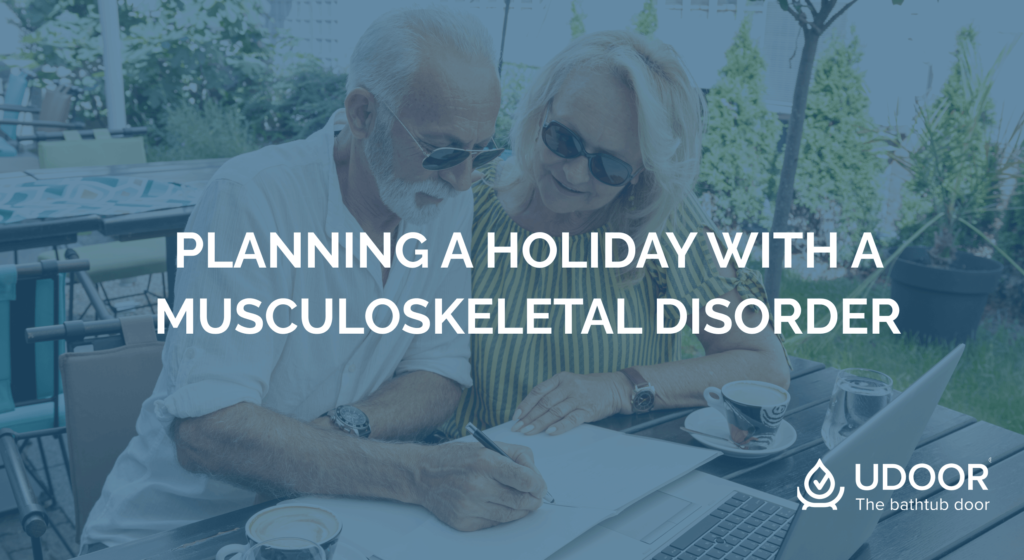Chronic pain from a joint replacement, fibromyalgia or back issue can often hold you back from making plans but with a little bit of extra preparation, you can ensure your condition doesn’t hold you back from enjoying your trip.
When planning a holiday it’s important to choose your destination wisely. Consider the accessibility of the destination, including the availability of accessible transportation, accommodation and attractions. Choose a place that has the right climate for you. A warm and humid climate may feel better if you have rheumatoid arthritis, but if you have osteoarthritis you may prefer a cooler climate. Travelling by sea or train allows for more frequent breaks and opportunities to move around while travelling.
Don’t know where to start? Here are some ideas for types of places you can start to explore:
Coastal retreats – enjoy the calming sound of waves and the healing power of sea air. Look for areas with flat coastal paths and if you plan to have a dip in the sea, a place with accessible changing rooms.
Nature escapes – Look for national parks and wildlife reserves with wheelchair-friendly trails, guided tours, and facilities designed to accommodate your needs.
Cruise holiday – cruise ships are equipped with facilities and services to cater to individuals with mobility challenges. They offer a convenient way to explore multiple destinations and often have an onboard doctor and medical facilities.
City breaks – many urban areas are becoming more accessible. Choose a destination known for accessible public transportation systems, smooth pavements, and disabled-friendly attractions. Museums, galleries, and cultural sites often provide accessibility measures to ensure everyone can enjoy them.
Spa retreats – pamper yourself with a relaxing retreatments specifically for musculoskeletal issues. Wellness centres often have professional staff trained in providing therapeutic massages, hydrotherapy, and treatments that can help alleviate discomfort and promote relaxation.
Accessible adventure travel – for those seeking an adrenaline rush, there are adventure travel companies that specialise in providing accessible experiences. From wheelchair-accessible hiking trails to adaptive skiing or scuba diving, these companies offer thrilling adventures designed to cater to different disabilities.
Once you’ve picked your destination, it’s time to book accessible accommodation and plan your itinerary. Choose a hotel or holiday rental that has accessible features, such as ramps or grab bars and walk-in bath or walk-in shower in the bathroom. Consider renting a scooter or wheelchair if walking long distances is a challenge.
Think about the activities you’ll be doing and how they may affect your condition. If you’re planning on sightseeing, take into account the distance and terrain involved. Opt for activities such as swimming, walking, or cycling, if you’re able to, which are beneficial for bone health without putting excessive strain on your skeletal system. Research activities and attractions that are suitable for your condition and consider making reservations ahead of time. Have flexibility in mind so that you can modify or reschedule activities if you feel your body needs rest.
Consider purchasing travel insurance to cover unexpected medical expenses or trip cancellations. Examine a map of the local area and mark nearby pharmacies and medical facilities in case you require any assistance or medical attention during your trip.
Before you leave, be sure to pack your medication, including any painkillers, anti-inflammatories, medical equipment and other supplements. Consider packing compression socks and knee or ankle braces which can help relieve pain and swelling. You can also bring along a small heating pad or ice pack if needed. Pack light and use luggage with wheels to avoid carrying heavy bags.
Every individual’s needs are different, so it’s essential to plan according to your specific condition and limitations and to prioritise self-care. With proper planning you can create wonderful memories while managing your condition effectively.
Do you have any other tips to add or your favourite holiday destination to visit?
Chronic pain from a joint replacement, fibromyalgia or back issue can often hold you back from making plans but with a little bit of extra preparation, you can ensure your condition doesn’t hold you back from enjoying your trip.
When planning a holiday it’s important to choose your destination wisely. Consider the accessibility of the destination, including the availability of accessible transportation, accommodation and attractions. Choose a place that has the right climate for you. A warm and humid climate may feel better if you have rheumatoid arthritis, but if you have osteoarthritis you may prefer a cooler climate. Travelling by sea or train allows for more frequent breaks and opportunities to move around while travelling.
Don’t know where to start? Here are some ideas for types of places you can start to explore:
Coastal retreats – enjoy the calming sound of waves and the healing power of sea air. Look for areas with flat coastal paths and if you plan to have a dip in the sea, a place with accessible changing rooms.
Nature escapes – Look for national parks and wildlife reserves with wheelchair-friendly trails, guided tours, and facilities designed to accommodate your needs.
Cruise holiday – cruise ships are equipped with facilities and services to cater to individuals with mobility challenges. They offer a convenient way to explore multiple destinations and often have an onboard doctor and medical facilities.
City breaks – many urban areas are becoming more accessible. Choose a destination known for accessible public transportation systems, smooth pavements, and disabled-friendly attractions. Museums, galleries, and cultural sites often provide accessibility measures to ensure everyone can enjoy them.
Spa retreats – pamper yourself with a relaxing retreatments specifically for musculoskeletal issues. Wellness centres often have professional staff trained in providing therapeutic massages, hydrotherapy, and treatments that can help alleviate discomfort and promote relaxation.
Accessible adventure travel – for those seeking an adrenaline rush, there are adventure travel companies that specialise in providing accessible experiences. From wheelchair-accessible hiking trails to adaptive skiing or scuba diving, these companies offer thrilling adventures designed to cater to different disabilities.
Once you’ve picked your destination, it’s time to book accessible accommodation and plan your itinerary. Choose a hotel or holiday rental that has accessible features, such as ramps or grab bars and walk-in bath or walk-in shower in the bathroom. Consider renting a scooter or wheelchair if walking long distances is a challenge.
Think about the activities you’ll be doing and how they may affect your condition. If you’re planning on sightseeing, take into account the distance and terrain involved. Opt for activities such as swimming, walking, or cycling, if you’re able to, which are beneficial for bone health without putting excessive strain on your skeletal system. Research activities and attractions that are suitable for your condition and consider making reservations ahead of time. Have flexibility in mind so that you can modify or reschedule activities if you feel your body needs rest.
Consider purchasing travel insurance to cover unexpected medical expenses or trip cancellations. Examine a map of the local area and mark nearby pharmacies and medical facilities in case you require any assistance or medical attention during your trip.
Before you leave, be sure to pack your medication, including any painkillers, anti-inflammatories, medical equipment and other supplements. Consider packing compression socks and knee or ankle braces which can help relieve pain and swelling. You can also bring along a small heating pad or ice pack if needed. Pack light and use luggage with wheels to avoid carrying heavy bags.
Every individual’s needs are different, so it’s essential to plan according to your specific condition and limitations and to prioritise self-care. With proper planning you can create wonderful memories while managing your condition effectively.
Do you have any other tips to add or your favourite holiday destination to visit?







